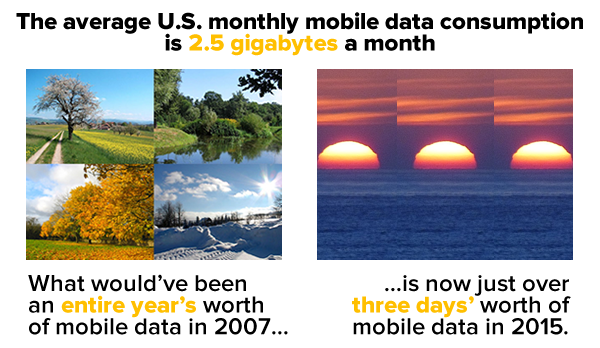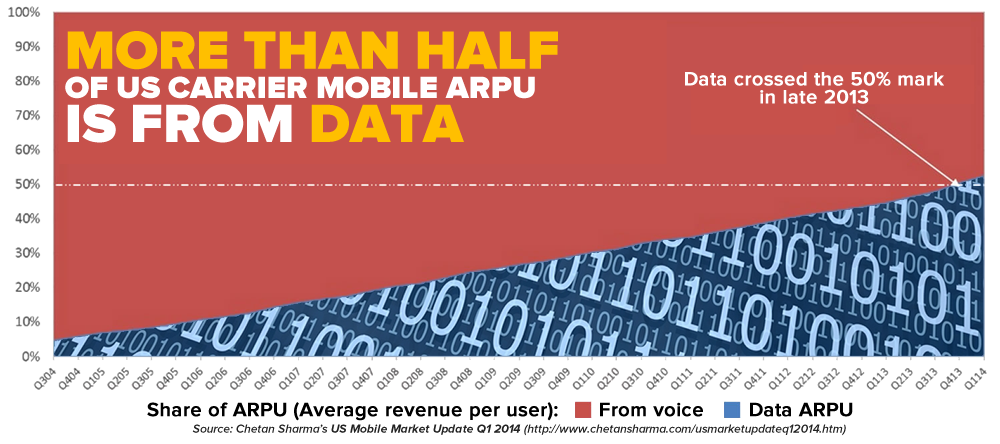Chetan Sharma’s Q1 state of the mobile market report

You can always count on consultant Chetan Sharma to provide insights about the mobile industry that are more than just valuable; they’re quite interesting as well! In his latest report, titled US Mobile Market Update Q1 2015, he reports on the growth of cellular data consumption. It took 20 years for American mobile users to reach the point where the average cellular data consumption rate was 1 gigabyte a month, but less than 4 quarters for the average to become 2 gigabytes a month. At the end of the first quarter of 2015, the average is 2.5 gigabytes a month. In Q1 2015, the average mobile user consumed as much cellular data in 75 hours as the average mobile user in 2007 would’ve used in a year.
Click the graph to see it at full size.
Sharma has been paying attention to the growth in mobile data usage. In his mobile market update from the same time last year, he observed that mobile carriers had reached the point where more of their ARPU (average revenue per user) was coming from data than from voice, and that they’ve adjusted their business models accordingly. That’s why we’ve seen a reversal over the past few years; in the pre-iPhone era, voice calls were limited and data wasn’t, and nowadays the opposite is true for a lot of plans. In US Mobile Market Update Q1 2015, Sharma has this to say about mobile data:
- Mobile data contributes to 62% of mobile carriers’ overall revenues.
- US carriers made more than $100 billion from mobile data last year, and they’re like to hit $132 billion this year.
- The two biggest mobile carriers, AT&T and Verizon, accounted for 70% of mobile data services revenue and 68% of subscribers in Q1 2015.
- In 2015, Verizon will become the first carrier to generate more than $50 billion from mobile data.

Other interesting news items that appear in Sharma’s report:
- Smartphone penetration in the U.S. is now at 76%, and they represented 95% of mobile phones sold in Q1 2015. Non-smartphones (sometimes kindly referred to as “feature phones” and less kindly as “dumbphones”) are now an endangered species.
- Connected devices — non-phone, non-tablet devices that use cellular networking — accounted for just more than half of net-new added mobile accounts in Q4 2014, and they’ll make up the majority of new mobile accounts in general. The lion’s share of connected devices in that time period were cars, which made up 68% of the new additions.
- People want even more mobile data: half of AT&T’s postpaid subscribers have data plans that provide at least 10 gigabytes a month.
- Mobile data growth contributes to the revenue of more than just carriers. 70% of Facebook’s quarterly revenues come from mobile, as does 89% of Twitter’s advertising revenue. Outside the world of web businesses, Starbucks, Sears, and Hertz are also generating significant revenue from mobile.
- T-Mobile’s “Uncarrier” strategy is paying off. In Q1 2015, they had more than 40% of all the net-new subscribers. With less than 300,000 subscribers separating T-Mobile and the next-largest competitor, Sprint, we should see them take the #3 slot in the “Big Four” sometime this year. Sharma calls this “more or less just a symbolic event with the transfer of bragging rights”, but if there’s someone who can get mileage out of such a symbolic event, it’s T-Mobile CEO John Legere.
We could go on about Sharma’s report, but we think it’s far better to show it to you instead. We’ve included his slides below:
The most important new feature in iOS 9
If you missed the livestream of the opening keynote at Apple’s Worldwide Developer Conference earlier this week, you can watch Apple’s recording, which runs about 2 hours and 24 minutes to find out about what’s new in iOS 9.
Or you could watch The Verge’s summary, which takes the highlights of the keynote and shrinks them to a more digestible 12 minutes:
Or you can take it from us and watch this video, which shows you what we think is the most important (and likely to be underappreciated) new feature in iOS 9:
For all these years, despite not having the limitations of physical keyboards, the iOS virtual keyboard letters have never changed to reflect the current case of the letters. A keyboard that shows upper-case letters when the shift key is engaged and lower-case letter when it isn’t has been a feature on Android and Windows Phone devices for some time now, and at long last, iPhones and iPads will have one as well. Consider how much time you’ve wasted wondering if shift lock was on and making upper-/lower-case corrections on your iOS devices, then multiply that hundreds of millions of users. This feature may be the one that creates the biggest gain in productivity — far more than Apple Music will, anyway.
Smartphones take over a Sports Illustrated cover

The cover of the June 15, 2015 issue of Sports Illustrated is supposed to be about the race horse American Pharoah winning the Triple Crown at the Belmont Stakes, but given that a sea of smartphones takes up the foreground, we think it’s also about how much mobile devices are a part of our lives now. Huffington Post sports takes a dimmer view of this, saying that the photo “epitomizes everything wrong with modern society”. We disagree; smartphones as we know them haven’t even been around a decade, and we’re still figuring out what’s possible with them.
Upon taking a closer look at the photo, we may have found something wrong: not with society, but with usability. Take a look at our zoomed-in view:

It shows someone who’s using their camera app, but will never be able to capture this historic moment because right then, the phone decided that it was time to show one of those notifications that won’t let you do anything until you dismiss it. Come on, mobile phone operating system vendors — make it so that our phones can give us notices and still not get in the way while we’re in the middle of something!



One reply on “Mobile roundup: State of the mobile market for Q1 2015, the most important feature in iOS 9, and smartphones take over a Sports Illustrated cover”
[…] when you’re in uppercase mode, and lowercase letters when you’re in lowercase mode. I wrote about it a month ago, in my June 10th article. I even called it “the most important feature in iOS 9″ and posted a video of this new […]